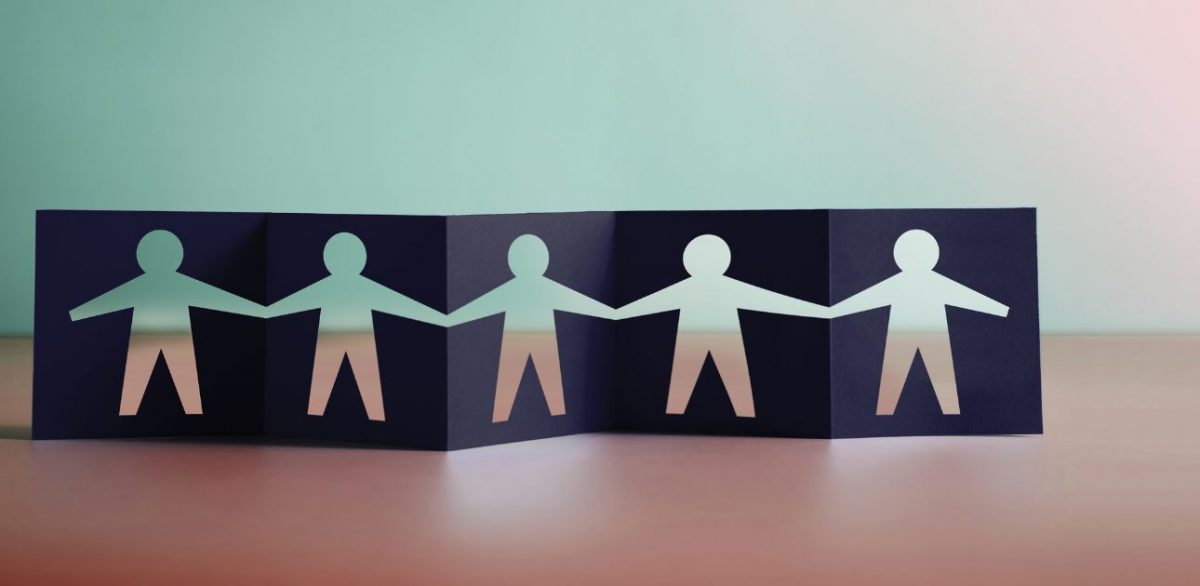Self-help groups have been touted as a panacea that will solve problems ranging from economic underdevelopment and women’s disempowerment, but do ground realities match the policy desirability?
—
FIVE months ago, Arti Devi took a loan of ₹10,000 from a year-old self-help group (SHG) in Delh’s Najafgarh area.
Devi’s husband had taken a loan from an informal source at a high interest rate. To return that loan, he had asked her to take another loan from the group.
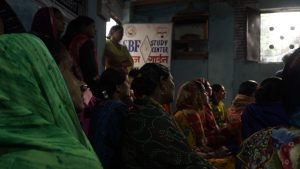

Women attending a monthly meeting in a Najafgarh-based self-help group.
The impact of the SHG model on the social and economic empowerment of women in India has been well documented. However, despite their positive impact, SHGs are reeling under issues such as restricted financial autonomy and business scalability; complex banking processes; the difficulty in changing the status of women within the family structure; and a pervasive lack of awareness regarding SHG practices.
SHGs are voluntary units made up of 10–20 individuals, typically women, belonging to similar economic and social backgrounds. Instituted in 2011 under the government’s National Rural Livelihoods Mission (NRLM), India’s 83 million SHGs have mobilised more than 75 million Indian households.
Almost nine out of ten SHGs are exclusively composed of women. This programme is being implemented across all states and Union territories in India, with the exception of Delhi and Chandigarh. However, there is no conclusive evidence of the lasting impact of SHGs on poverty alleviation and household well-being.
Arti Devi came to Delhi from Bihar’s Samastipur in 2018. Ever since, her husband has been working as a rickshaw driver. She has four daughters and a son.
“Fortunately, funds were available at that time, so I was able to help him. I got the loan because I was the one who needed it the most at that time,” she says.
While joining the group, Devi had in mind that being a part of such groups could be helpful during critical moments in life, for instance, while making arrangements for the marriage of her daughters.
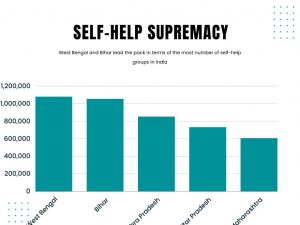

Access to loans: The dynamics of business and loan utilisation
Roshan Biwi is a 38-year-old who lives in Murli Basant Pur, Saharsa, Bihar. She and her husband are the earning hands in a family of five. Her husband is a daily wage worker and has a small tailoring business.
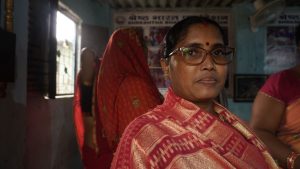

A self-help group member in Najafgarh.
Around four–five years ago, Biwi joined an SHG after she came to know about it through other women in the village who were already a part of the group. She took a loan of ₹75,000 from the group, as her husband needed it to sustain his business.
“I spent some money on building my house as well. I make monthly repayments to the group ranging from ₹1,000 to ₹2,000. However, the amount is not consistent, and largely depends upon our income,” she says.
In India, not only are there fewer women-owned businesses, but financial resources for those that exist are also sparse. Despite the government’s doubling of collateral-free loans to women’s SHGs in the economic stimulus package by the Union finance minister Nirmala Sitharaman, the average disbursed loan amount remains low.
The appeal of microfinance units is largely in their high repayment rates, which draw formal financial institutions into the sector. “It is obvious that if you are going to charge very high interest with a very short repayment time, the loans cannot be used for productive purposes,” says developmental economist Jayati Ghosh.
“No production process will give you 25 percent return and above within such a limited time. The very notion that you can expect that kind of loan to be used for productive purposes is mistaken. People use such loans for consumption, and to tide over difficult times. It is not surprising,” she adds.
The Micro Finance Institutions Bill has been under scrutiny due to the imposition of high interest rates and harsh recovery methods. For example, in states such as Andhra Pradesh, irregularities led some women borrowers from SHGs to suicide. In a 2007 study of 2,750 SHGs, it was found that most women had not received any capacity-building inputs for two years.
Rajmani Poddar, 45, who lives in Ganga Vihar, New Delhi, says, “I have been with an SHG for over a year now. I, along with many other women joined thinking we would get some type of work to do. However, we have not received any training or business so far.”
“I don’t see any benefit in this if women are not engaged in any sort of profession. Otherwise, you keep submitting hundred rupees, money gets collected in the group, and people can borrow,” she says.
Additionally, underspending has been an emerging issue in SHGs, where there is a significant disparity between the allocated amount and the actual expenditure. It can be found in Rajya Sabha data for the year 2022–23 of the NRLM allocations.
For instance, out of ₹54,852 crore allocated to West Bengal, only ₹7,089 crore was used. In Bihar, the allocated amount was ₹102,658 crore, wherein only ₹16,893 crore was spent. This leads to questions about the on-ground implementation of programmes such as NRLM.
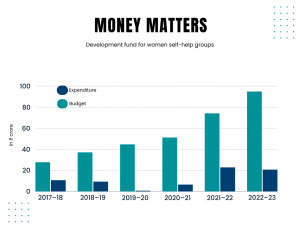

Economist and gender policy specialist Mitali Nikhore says, “Underspending is starting to come up as a challenge. Earlier it was not this way. In the first decade of the scheme, World Bank funding was also involved, which was one of the major partners of the scheme with the government of India. Their monitoring framework, and technical assistance were very strong. They ensured the scheme was running with international best practices.”
She further explains that while the economy has changed, the scheme itself has not changed with time, “It becomes important for the scheme guidelines to adapt with the dynamic economy of the current time.”
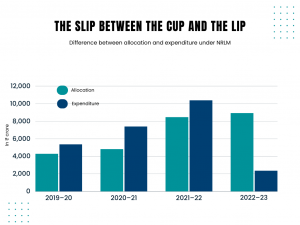

Women as borrowers, men as decision-makers
In certain cases, women join SHGs under family pressure, where men act as the primary decision-makers. Even after securing loans, women often find themselves in roles where their husbands manage businesses.
“SHGs are promoted through a system of microfinance which is a credit system where each member is assured to get a certain amount of money. The basic agenda of that money is to promote livelihood through women’s participation.
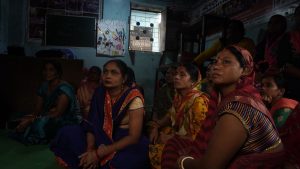

Women attending a monthly meeting in a Najafgarh-based self-help group.
This is the theoretical understanding of what an SHG is and why it is there. However, there are plenty of examples of men being the decision-makers in the family structure. Some communities still do not allow their women to join SHGs,” says Sanjana Kaushik, manager, Village Square, and a development professional with extensive experience working with SHGs.
In Najafgarh, 35-year-old Pooja, who relocated from Bihar after her marriage, applied for a loan of ₹1,50,000 through her State Bank of India account. Two inquiries were made regarding the purpose of the loan. “I opened a cloth shop. We didn’t receive cash; we only got the material. The money is not given in hand,” she explains.
Pooja shares that her husband persuaded her to take a loan under the name of the SHG she was associated with to establish a cloth business in order to build a better life.
“My husband manages the shop. With kids and household responsibilities, I can’t handle everything. I visit the shop for an hour or two, but mostly, my husband takes care of it,” she adds. Her husband also owns a barber shop.
“It happens that sometimes women take loans to support their husband’s businesses or to support their household. Most of the loans are taken for farming or to manage their shops, maybe general stores or clothing stores. Sometimes, they also take it for personal reasons such as a marriage in the family, but we generally don’t give it to them.
“We know if they are doing business of some sort, then only they will be able to repay the loan. The manager of the group is usually from the same community and is responsible for checking if the loan is for personal reasons. We still cannot guarantee. We just check the background of the members,” said Roshni Kumar, Community Coordinator, JEEViKA, Fatuha block, Bihar.
While the SHG model has made significant progress in the economic empowerment of women, in certain regions, a big gap between the policy objectives and on-the-ground outcomes, such as reports highlighting the model’s tendency to exclude the poorest of the poor from the scheme, continues to hamstring the institution.

